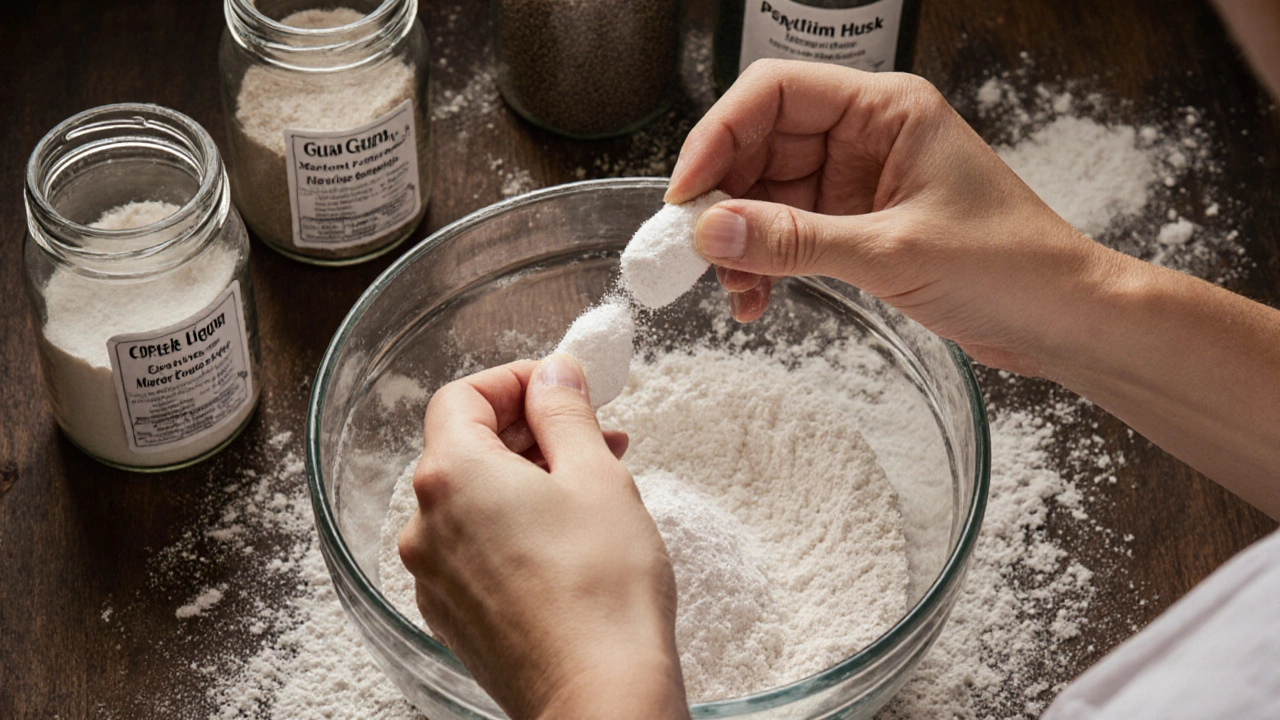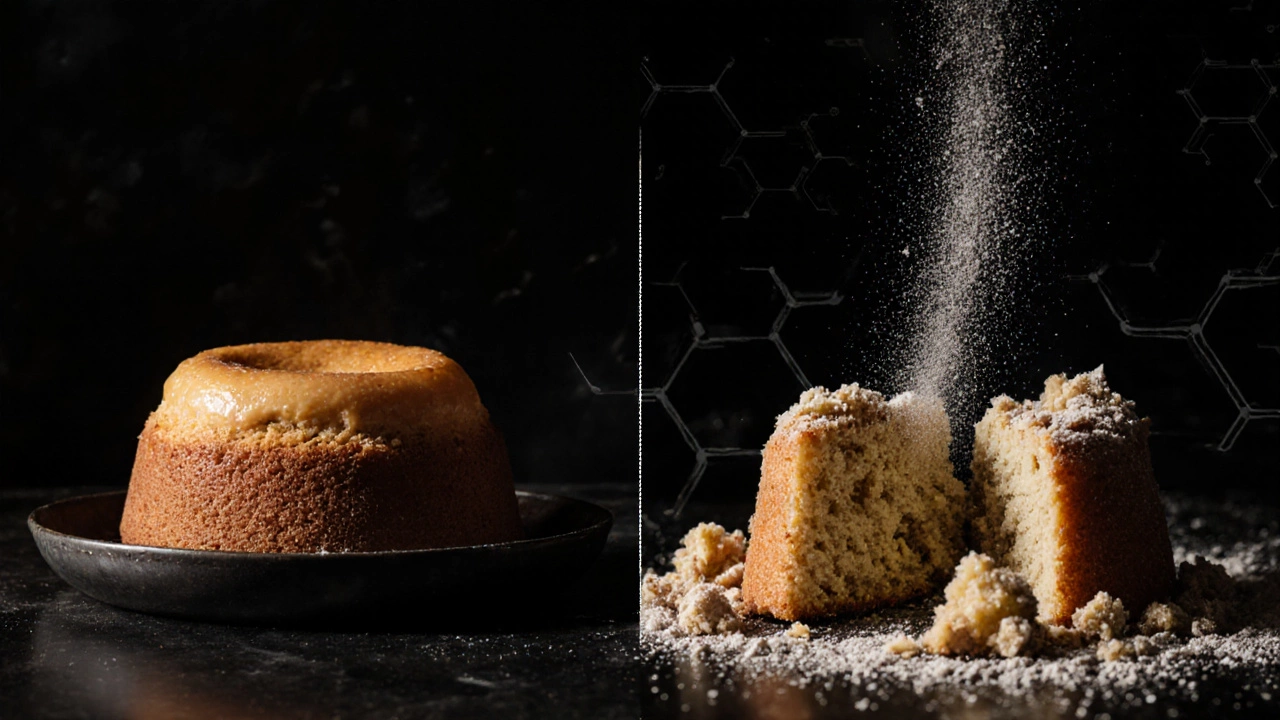Xanthan Gum Safety Checker
Is Your Xanthan Gum Safe?
Safety Result
Recommended Amount
Alternatives
When you’re baking a gluten-free cake and reach for xanthan gum, you’re not just grabbing a powder-you’re trusting it to hold your whole recipe together. But if you have celiac disease or a gluten sensitivity, that little jar raises a big question: is xanthan gum gluten-free?
Yes, xanthan gum is naturally gluten-free
Xanthan gum comes from bacteria called Xanthomonas campestris. These microbes ferment sugar-usually from corn, soy, or wheat-to produce a slimy substance. That substance is then dried and ground into a fine powder. The final product contains no gluten proteins, even if wheat sugar was used in the fermentation process. That’s because the fermentation and purification steps break down and remove all traces of gluten.The U.S. Food and Drug Administration (FDA) and the European Food Safety Authority (EFSA) both recognize xanthan gum as safe for people with gluten intolerance. In fact, it’s one of the most common thickeners in certified gluten-free products, from pancake mixes to chocolate bars.
But here’s the catch: cross-contamination
Just because xanthan gum is naturally gluten-free doesn’t mean every brand is safe. Some manufacturers process it in facilities that also handle wheat, barley, or rye. If equipment isn’t cleaned properly, tiny bits of gluten can sneak in. That’s enough to trigger a reaction in someone with celiac disease, even if the amount is below 20 ppm-the legal limit for gluten-free labeling in the U.S.Look for brands that explicitly say “certified gluten-free” on the label. Companies like Bob’s Red Mill, King Arthur Flour, and NOW Foods test their xanthan gum for gluten and label it accordingly. If a package just says “gluten-free” without certification, ask yourself: does this brand have a dedicated gluten-free line? Do they test every batch? If you can’t find answers, play it safe.
Why do gluten-free bakers rely on xanthan gum?
Without gluten, your cake batter falls apart. Gluten gives structure, elasticity, and chew. Xanthan gum steps in as a stand-in. It binds water, traps air bubbles, and gives dough a stretchy texture-almost like gluten does. In gluten-free cake recipes, it’s usually used in tiny amounts: about 1/4 to 1/2 teaspoon per cup of flour blend.Too much xanthan gum? Your cake turns gummy, rubbery, or slimy. Too little? It crumbles like dry sand. That’s why most gluten-free flour blends already include it. If you’re making your own blend, you’ll need to add it separately.

What are the alternatives if you’re sensitive to xanthan gum?
Some people react to xanthan gum-not because of gluten, but because of the fermentation process or their gut sensitivity. If you’ve tried it and your stomach still feels off, you’re not alone. Here are three common gluten-free replacements:- Guar gum: Made from guar beans, it’s milder than xanthan gum. Use about 50% more than xanthan gum (e.g., 3/4 teaspoon instead of 1/2). It doesn’t hold air as well, so it’s better for dense cakes than fluffy ones.
- Psyllium husk powder: This one’s great for structure. Use 1 teaspoon per cup of flour. It absorbs a lot of water, so you’ll need to add extra liquid to your recipe.
- Chia or flaxseed gel: Mix 1 tablespoon of ground chia or flax with 3 tablespoons of water. Let it sit for 10 minutes until it gels. It adds fiber and omega-3s but can darken your cake slightly.
Each substitute behaves differently. Guar gum works well in cookies. Psyllium gives bread-like chew. Chia gel adds moisture. Test small batches before committing to a whole cake.
How to spot hidden gluten in gluten-free products
Just because a cake mix says “gluten-free” doesn’t mean it’s safe. Some brands use maltodextrin, modified food starch, or dextrin-all of which can come from wheat. Always check the ingredient list for:- Wheat, barley, rye, or oats (unless labeled gluten-free)
- Malt or malt flavoring
- Modified food starch without a source (if it just says “starch,” assume it’s wheat unless stated otherwise)
- “Natural flavors” or “hydrolyzed vegetable protein” without clarification
When in doubt, go for products with a certified gluten-free logo. The Gluten-Free Certification Organization (GFCO) and the Celiac Support Association (CSA) require testing below 10 ppm-stricter than the FDA’s 20 ppm standard.

Real-world example: A gluten-free cake recipe that works
Here’s what a simple, reliable gluten-free vanilla cake looks like:- 1 1/2 cups gluten-free flour blend (with xanthan gum already included)
- 3/4 cup granulated sugar
- 1/2 cup unsalted butter (or dairy-free alternative)
- 2 large eggs
- 1 teaspoon vanilla extract
- 1 teaspoon baking powder
- 1/2 teaspoon salt
- 3/4 cup milk (or non-dairy milk)
If your flour blend doesn’t include xanthan gum, add 1/2 teaspoon. Bake at 350°F for 25-30 minutes. The cake should spring back when lightly pressed. If it’s too crumbly, you didn’t use enough binder. If it’s gummy, you used too much.
Final checklist: Is your xanthan gum safe?
Before you use xanthan gum in your next gluten-free cake, run through this quick list:- Is the label certified gluten-free? (Look for GFCO, CSA, or NSF logos)
- Does the brand state whether it’s made in a dedicated gluten-free facility?
- Are you using it in the right amount? (1/4-1/2 tsp per cup of flour)
- Have you tested it before in other recipes? (Some people react to xanthan gum even without gluten)
- Are you storing it in a clean, dry container away from wheat flour?
Most people with gluten intolerance can use xanthan gum safely-especially if they choose certified brands. But it’s not magic. It’s a tool. Use it right, and your cake will rise, hold, and taste like dessert. Use it wrong, and you’ll end up with a sticky mess.
Is xanthan gum safe for people with celiac disease?
Yes, xanthan gum is safe for people with celiac disease as long as it’s certified gluten-free. The fermentation process removes all gluten proteins, but cross-contamination during manufacturing can occur. Always choose products labeled “certified gluten-free” to avoid risk.
Can xanthan gum cause digestive issues?
Some people experience bloating, gas, or loose stools from xanthan gum, especially in large amounts. This isn’t due to gluten-it’s because xanthan gum is a soluble fiber that ferments in the gut. Start with small amounts and increase gradually. If symptoms persist, try guar gum or psyllium husk instead.
Does xanthan gum contain soy or corn?
Xanthan gum is made by fermenting sugars, which often come from corn, soy, or wheat. Most commercial brands use corn sugar. If you have a soy or corn allergy, check the label. Some manufacturers specify the source. Brands like Bob’s Red Mill use corn-derived xanthan gum and clearly label it.
Can I skip xanthan gum in gluten-free baking?
You can skip it, but your baked goods will likely crumble or fall apart. Xanthan gum gives structure and moisture retention. If you avoid it, use alternatives like psyllium husk, chia gel, or guar gum. But don’t expect the same texture-gluten-free baking requires binders to mimic gluten’s role.
Why do some gluten-free flour blends include xanthan gum and others don’t?
Some blends include it to simplify baking-so you don’t have to measure it separately. Others leave it out so you can control the amount based on your recipe. Flour blends designed for cakes usually include less xanthan gum than those for bread, since cakes need less structure. Always check the label before buying.